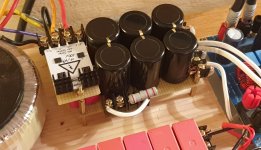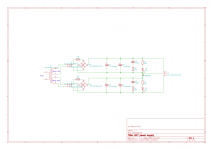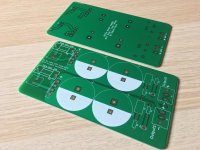Hello Tibi, i switched to this new thread to post my feedback about Saligny HVHF used for the anode PSU in my DIY hybrid amplifier, even if it is a Mk I version, as i think my experience could be helpful for this GB hesitant followers.
As i reported earlier, i alrady implemented HVHF Salignys for the ss current amplifying part of the same amplifier, finding better speaker drive and speed but no substantial change in sound signature (that was expected, due to the position). Later, i replaced Hexfred diodes in the anode PSU feeding the voltage amplifier tubes (a pair of Siemens D3A) with another, higher voltage, HVHF; i waited some months before posting to allow complete break-in.
First of all, i have to say that i had chosen Hexfred diodes in my amplifier as they are the ss solution that sounds best for my ears, surely among the closest to a decent rectifier valve (that i could not implement): very detailed but not "cold". I also tried many other diodes, including Schottky and Cree, but they always sounded better to my ears. So not easy to better...
But Saligny HVHF really kicked me off my socks! Totally unexpected! Just an higher, better level - or maybe two or three levels...
Any sound harshness/roughness simply disappeared, leading to very natural and lifelike mids and harmonious highs. Instruments space separation benefited too, with very well "carved" body. Tube amplifier sound combined with ss precision.
I absolutely recommend the upgrade to anyone using tube-based voltage/pre amplification and in general for anode power supplies!
Thank you Tibi, this time you really surprised me! And surely Mk II will be even better...
As i reported earlier, i alrady implemented HVHF Salignys for the ss current amplifying part of the same amplifier, finding better speaker drive and speed but no substantial change in sound signature (that was expected, due to the position). Later, i replaced Hexfred diodes in the anode PSU feeding the voltage amplifier tubes (a pair of Siemens D3A) with another, higher voltage, HVHF; i waited some months before posting to allow complete break-in.
First of all, i have to say that i had chosen Hexfred diodes in my amplifier as they are the ss solution that sounds best for my ears, surely among the closest to a decent rectifier valve (that i could not implement): very detailed but not "cold". I also tried many other diodes, including Schottky and Cree, but they always sounded better to my ears. So not easy to better...
But Saligny HVHF really kicked me off my socks! Totally unexpected! Just an higher, better level - or maybe two or three levels...
Any sound harshness/roughness simply disappeared, leading to very natural and lifelike mids and harmonious highs. Instruments space separation benefited too, with very well "carved" body. Tube amplifier sound combined with ss precision.
I absolutely recommend the upgrade to anyone using tube-based voltage/pre amplification and in general for anode power supplies!
Thank you Tibi, this time you really surprised me! And surely Mk II will be even better...
Dear Tibi and diyaudio audio enthusiasts,
Same as previous post, I would also like to share my feedback, after one week of experimentation. I do not have any good measurement tool except my ears. Some would say it's the best device, some other the worst. In any case, it's only my own appreciation from a not so expert guy.
I received my package last Monday in good conditions.
Same day the awaited HVHF has been quickly installed in one linear PSU that I built for an amplifier made with the TPA3251EVM development kit from TI. Only the RURG3060 diodes (Ultra fast, slow recovery) haves been replaced. Otherwise everything is the same than before. Switched on and immediately heard something great happening. I listened so many hours before modification that I easily recognized improvements in the music. This was surprising to me, because I already spent so many time and budget to improve musicality and I was proud of the result, but I was wrong. Seems that my power supply was still noisy (diode noise, ringing ?) and the allegation that with this component the source of diode noise is killed is true.
- darker sound with HVHF than RURG diodes. Although I made some effort to fine tune the system in the past, I still felt it a little dry with high pitch. I thought the ESS 9038 DAC was guilty. But I was wrong. With HVHF in place, this has changed. Now I can appreciate a mouthful of fuller music. And the exacerbation of highs that sometimes triggered my right ear tinnitus never came back since Monday. This made listing sessions more addictive with no listening fatigue.
- fatter sound but still quick with more energy packed in each note I can feel. Sustained bass, heavier piano notes I like very much. The whole musical image has more contrast, thus easier listing again.
- more detailed with subtleties I never perceived before. I thought also here there was no improvement possible. But some higher resolution file like Seamus from Meddle Pinkfloyd 24/96 proved the opposite and the dogs really entered my listening room like never before.
- voices moved more in the forefront. Very pleasant listening of Operas and track with nice voices. Was a bit shy before, now sometimes a bit too much, but I rather blame my speakers and listening environment.
-truthiness of instruments. Here it's really different and shines. Especially classic tracks with wind instruments
Specification of the modified PSU :
-300VA 24VAC Vigortronix toroid transformer -CRCRCCCC setup with C=8200*µF Mundorf M-Lytic AG (50000µF in total) and R=2.2Ohm Wima FKP1 0.1 bypass before last R. -RURG 3060 diode before HVHF.I came to these components after many hours spent or diode tests, cap and snubber attempts across diodes and rail and R value and positions. The setup above gave the best listening experience, given the fact that my 95db efficiency are not too difficult to drive.

Many thanks Tibi for offering this very nice device. Small question : I received the old HVHF. What is the difference between this one and the new MKII ?
Best Regards
Dominique
Same as previous post, I would also like to share my feedback, after one week of experimentation. I do not have any good measurement tool except my ears. Some would say it's the best device, some other the worst. In any case, it's only my own appreciation from a not so expert guy.
I received my package last Monday in good conditions.
Same day the awaited HVHF has been quickly installed in one linear PSU that I built for an amplifier made with the TPA3251EVM development kit from TI. Only the RURG3060 diodes (Ultra fast, slow recovery) haves been replaced. Otherwise everything is the same than before. Switched on and immediately heard something great happening. I listened so many hours before modification that I easily recognized improvements in the music. This was surprising to me, because I already spent so many time and budget to improve musicality and I was proud of the result, but I was wrong. Seems that my power supply was still noisy (diode noise, ringing ?) and the allegation that with this component the source of diode noise is killed is true.
- darker sound with HVHF than RURG diodes. Although I made some effort to fine tune the system in the past, I still felt it a little dry with high pitch. I thought the ESS 9038 DAC was guilty. But I was wrong. With HVHF in place, this has changed. Now I can appreciate a mouthful of fuller music. And the exacerbation of highs that sometimes triggered my right ear tinnitus never came back since Monday. This made listing sessions more addictive with no listening fatigue.
- fatter sound but still quick with more energy packed in each note I can feel. Sustained bass, heavier piano notes I like very much. The whole musical image has more contrast, thus easier listing again.
- more detailed with subtleties I never perceived before. I thought also here there was no improvement possible. But some higher resolution file like Seamus from Meddle Pinkfloyd 24/96 proved the opposite and the dogs really entered my listening room like never before.
- voices moved more in the forefront. Very pleasant listening of Operas and track with nice voices. Was a bit shy before, now sometimes a bit too much, but I rather blame my speakers and listening environment.
-truthiness of instruments. Here it's really different and shines. Especially classic tracks with wind instruments
Specification of the modified PSU :
-300VA 24VAC Vigortronix toroid transformer -CRCRCCCC setup with C=8200*µF Mundorf M-Lytic AG (50000µF in total) and R=2.2Ohm Wima FKP1 0.1 bypass before last R. -RURG 3060 diode before HVHF.I came to these components after many hours spent or diode tests, cap and snubber attempts across diodes and rail and R value and positions. The setup above gave the best listening experience, given the fact that my 95db efficiency are not too difficult to drive.

Many thanks Tibi for offering this very nice device. Small question : I received the old HVHF. What is the difference between this one and the new MKII ?
Best Regards
Dominique
Last edited:
Wow! Thank you very much Dominique !
The difference between HVHF MKII and the old one, is that in MKII I have improved power supply and I'm using some quite new ON semiconductor mosfet's, called SUPERFET III. Soooo cool name!
These are a bit expensive but offer Vds>650V, low Rdson at an unexpected low Qgs. That mean higher current at higher frequency. Entire PCB was redesigned, because these mosfets have a "strange" capsule where gate is on opposite place and don't match any other mosfet. Therefore PCB was redesigned and HVHF MKII will be only for this mosfet type targeting high voltage tube applications. I expect to kill the rumour that semiconductors do not sound good as rectifiers.
Old HVHF is more customisable, as I can use a wide range of mosfets and therefore I can offer custom variation for almost any application. Saligny HVHF "old one" will be around for a while.
Regards,
Tibi
The difference between HVHF MKII and the old one, is that in MKII I have improved power supply and I'm using some quite new ON semiconductor mosfet's, called SUPERFET III. Soooo cool name!
These are a bit expensive but offer Vds>650V, low Rdson at an unexpected low Qgs. That mean higher current at higher frequency. Entire PCB was redesigned, because these mosfets have a "strange" capsule where gate is on opposite place and don't match any other mosfet. Therefore PCB was redesigned and HVHF MKII will be only for this mosfet type targeting high voltage tube applications. I expect to kill the rumour that semiconductors do not sound good as rectifiers.
Old HVHF is more customisable, as I can use a wide range of mosfets and therefore I can offer custom variation for almost any application. Saligny HVHF "old one" will be around for a while.
Regards,
Tibi
Last edited by a moderator:
This is an active power supply designed to accommodate Saligny Standard.
Design is open-source. All surce files attached.
BOM and gerber archive included.
To open files use KiCad 5.99.
Enjoy !
Regards,
Tibi
Design is open-source. All surce files attached.
BOM and gerber archive included.
To open files use KiCad 5.99.
Enjoy !
Regards,
Tibi
Attachments
Last edited by a moderator:
Answering here on some personal messages:
Fuse model is from this page Kicad
Any Saligny bridge can be ordered by subscribing to GB google sheet, or by pm me.
Saligny Standard is pin compatible with any GBU bridge and active power supply will work with a normal bridge as well, so use what you consider best. I do not mind if you use this design with a GBU bridge.
Active power supply pcb can ordered using gerber archive at jlcpcb for under 2$/pcb (I'm not affiliated with them).
Please use thread for technical questions. PM is for personal messaging. Thanks !
Regards,
Tibi
Fuse model is from this page Kicad
Any Saligny bridge can be ordered by subscribing to GB google sheet, or by pm me.
Saligny Standard is pin compatible with any GBU bridge and active power supply will work with a normal bridge as well, so use what you consider best. I do not mind if you use this design with a GBU bridge.
Active power supply pcb can ordered using gerber archive at jlcpcb for under 2$/pcb (I'm not affiliated with them).
Please use thread for technical questions. PM is for personal messaging. Thanks !
Regards,
Tibi
Hi Tibi,
Thanks for the active power supply pcb. I allready ordered some at jlcpcb
and now I need some more rectifiers... I placed the order in the google sheet.
Small question : is the snubber in the pcb still necessary ?
And in BOM snubber value is 100nF while in schematic is 220nF ?
Regards
Thanks for the active power supply pcb. I allready ordered some at jlcpcb
and now I need some more rectifiers... I placed the order in the google sheet.
Small question : is the snubber in the pcb still necessary ?
And in BOM snubber value is 100nF while in schematic is 220nF ?
Regards
Last edited:
Hi Greinedo,
Thank you for your observation.
There is no need for snubber if you use synchronous rectifier.
However the PCB s not restricted to Saligny and can be used with a wide range of diode bridges.
Publicity spot open !
************
But, I must mention that, even with snubbers a normal diode bridge will not be even close in therms of noise and dynamic performance compared with a well made synchronous rectifier. Will take a while till people realise "This is the way".
************
End of the publicity spot ! :-D
In case of a diode bridge, the proper value for C5 and C6 is 100nF or 220nF and 10ohm resistors must be adjusted on a scope, till diode on/off switching noise is minimised.
Regards,
Tibi
Thank you for your observation.
There is no need for snubber if you use synchronous rectifier.
However the PCB s not restricted to Saligny and can be used with a wide range of diode bridges.
Publicity spot open !
************
But, I must mention that, even with snubbers a normal diode bridge will not be even close in therms of noise and dynamic performance compared with a well made synchronous rectifier. Will take a while till people realise "This is the way".
************
End of the publicity spot ! :-D
In case of a diode bridge, the proper value for C5 and C6 is 100nF or 220nF and 10ohm resistors must be adjusted on a scope, till diode on/off switching noise is minimised.
Regards,
Tibi
Hi John ! Yes it is possible.
You may use 9Vac spare, but considering some power dissipation. At 9Vac input and 5Vdc output, Zeno MKII will have a drop-over voltage of (9x1,41)-5=7,69Vdc. If you run Zeno MKII at 1A, there will be 7,69W to dissipate an you'll nee a proper heatsink. At 4A, power dissipated become important and you'll need a heatsink to dissipate over 30W.
Regards,
Tibi
You may use 9Vac spare, but considering some power dissipation. At 9Vac input and 5Vdc output, Zeno MKII will have a drop-over voltage of (9x1,41)-5=7,69Vdc. If you run Zeno MKII at 1A, there will be 7,69W to dissipate an you'll nee a proper heatsink. At 4A, power dissipated become important and you'll need a heatsink to dissipate over 30W.
Regards,
Tibi
- Home
- Group Buys
- 3rd group buy for Synchronous Bridge aka Ideal Bridge

